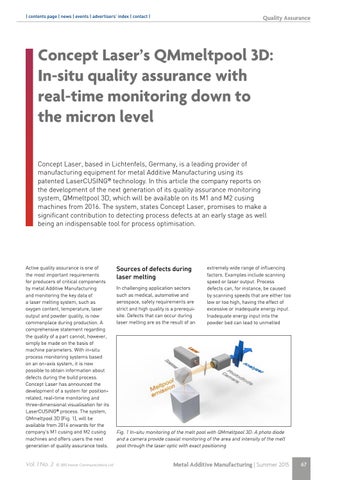| contents page | news | events | advertisers’ index | contact |
Quality Assurance
Concept Laser’s QMmeltpool 3D: In-situ quality assurance with real-time monitoring down to the micron level Concept Laser, based in Lichtenfels, Germany, is a leading provider of manufacturing equipment for metal Additive Manufacturing using its patented LaserCUSING® technology. In this article the company reports on the development of the next generation of its quality assurance monitoring system, QMmeltpool 3D, which will be available on its M1 and M2 cusing machines from 2016. The system, states Concept Laser, promises to make a significant contribution to detecting process defects at an early stage as well being an indispensable tool for process optimisation.
Active quality assurance is one of the most important requirements for producers of critical components by metal Additive Manufacturing and monitoring the key data of a laser melting system, such as oxygen content, temperature, laser output and powder quality, is now commonplace during production. A comprehensive statement regarding the quality of a part cannot, however, simply be made on the basis of machine parameters. With in-situ process monitoring systems based on an on-axis system, it is now possible to obtain information about defects during the build process. Concept Laser has announced the development of a system for positionrelated, real-time monitoring and three-dimensional visualisation for its LaserCUSING® process. The system, QMmeltpool 3D (Fig. 1), will be available from 2016 onwards for the company’s M1 cusing and M2 cusing machines and offers users the next generation of quality assurance tools.
Vol. 1 No. 2 © 2015 Inovar Communications Ltd
Sources of defects during laser melting In challenging application sectors such as medical, automotive and aerospace, safety requirements are strict and high quality is a prerequisite. Defects that can occur during laser melting are as the result of an
extremely wide range of influencing factors. Examples include scanning speed or laser output. Process defects can, for instance, be caused by scanning speeds that are either too low or too high, having the effect of excessive or inadequate energy input. Inadequate energy input into the powder bed can lead to unmelted
Fig. 1 In-situ monitoring of the melt pool with QMmeltpool 3D: A photo diode and a camera provide coaxial monitoring of the area and intensity of the melt pool through the laser optic with exact positioning
Metal Additive Manufacturing | Summer 2015
67
